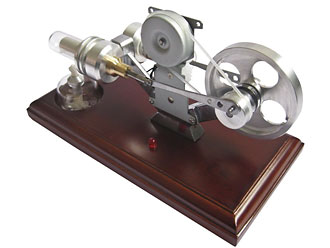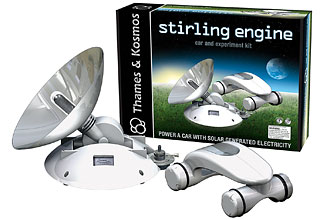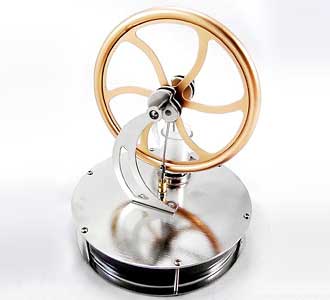LTD Stirling Engine
What is a LTD Stirling engine?

Similar to a typical Stirling engine an LTD Stirling engine runs when one part of the engine is heated and another part is cooled. LTD is short for Low Temperature Differential. When a Stirling engine has a Low Temperature Differential it means that it can run when the warm side is not much warmer than the cool side. Put another way, the difference between the warm and cool side is very small. Some LTD engines can run on as little as 1/2° C.
HB6 – Coffee Stirling engine
Very small difference in heat needed
The temperature difference required to run an LTD Stirling engine is so small that it broadens the selection of usable heat sources. If large scale LTD Stirling engines are ever commercially developed it would mean a more effective use of energy sources.
Possible heat sources
- Passive solar
- Geothermal energy
- Landfill heat energy
- Captured heat from homes
- Waste heat from industrial processes
- Automobile engine waste heat
Large LTD Stirling engine powered by solar heated oil
Here is a video of a the largest LTD engines that I’ve seen. These engines implement the use of passive solar energy. I love the sound that is made by these LTD engines. There is a good article on this engine at www.solarheatengines.com/Tamera
Availability of LTD engines
Currently most of the available LTD Stirling engines are smaller model sized engines. These are usually purchased for demonstration in an educational setting. However, many are purchased by model engine enthusiasts too.
Basic components and operation
The basic elements of an LTD engine are the same as any other conventional Stirling engines. The most common LTD engine configuration is a Gamma type Stirling.
List components
- Piston (often made of graphite)
- Displacer (often made of Styrofoam type material)
- Cylinder (made of glass sometimes metal)
- Connecting rods and linkages (usually precision machined metal)
- Flywheel (make from metal, glass or Plexiglas)
- Hot side plate or heat exchanger (made from metal, usually Aluminum)
- Cold side plate or heat exchanger (made from metal, usually Aluminum)
The Shape of an LTD

The Geometry of an LTD engine is distinct when compared to an engine with a large heat differential. The shape of an LTD engine is limited by the physical laws of the universe. So they have a relatively large volume of working fluid and displacer to compensate for the small amounts of energy available when running on such small heat differences.
Stirling engines use a working fluid (gas) in many cases typical atmospheric air. The air must be sufficiently heated to expand and push the piston outward the appropriate distance for the engine to operate.
In the case of a high temperature differential Stirling a relatively small amount of gas is heated. An LTD Stirling engine aims to do the opposite. To offset the small heat difference it heats a relatively large amount of gas.
This leads to LTD Stirling engine designs that have a relatively large surface area for the heating and cooling plates. These plates allow a larger volume of gas to be affected.
It is also necessary to have a displacer that has nearly the same surface area as the heating and cooling plates. The displacer is almost always light weight and has high insulative properties.

Because of the large surface area needed for the hot and cold plates LTD Stirling engines have many interesting configurations. Once you understand how a Stirling engine works it’s easy to identify an LTD.
LTD engines have a large volume of working fluid (the gas inside the engine) getting heated and cooled relative to the drive piston volume, sometimes 50 to 1. This relationship also plays a large role in determining the engine shape.
A correctly shaped displacer is needed in order to move a large volume of gas. Also, a light weight displacer with a large surface and a short stroke are necessary and typical for LTD engines.
Running an LTD Stirling engine
LTD Stirling engines can run as long as there is enough of a temperature difference between the warm and cool plates. The cool plate is usually only in contact with the atmosphere. So if you’re indoors the heat sink is the air in the room. Sometimes the room can be the heat source. If you put ice on the cold side plate then the heat will flow from the room through the engine and into the ice.
There is a great animation at Animated Engines.com that shows an LTD in action.
Books on the topic
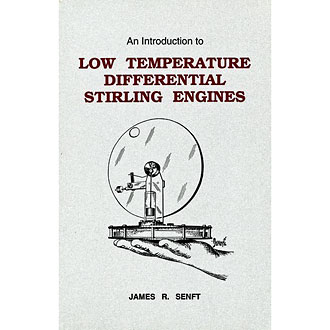
An Introduction to Low Temperature Differential Stirling Engines By Jame R. Senft is a great introduction to LTD engines. The book includes the history, theory, operation and even a set of plans to build an LTD Stirling engine.
Other sources of heat for model LTD engines
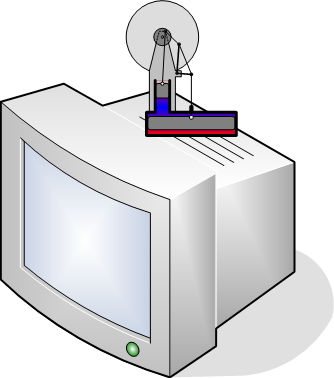
So anything that is warm enough to create the small heat difference necessary to run an LTD will work. In many cases just the heat of your hand.
- The heat rising off of a CRT computer monitor.
- The heat rising off of your computer.
- Evaporation of water off of the cool side plate.
- The heat of the sun hitting the warm plate (this can be the top if the engine is running in reverse).
- Ice on the cold side of the LTD Stirling engine (this can also be either side of most LTD engines).
- The heat of a light bulb.
- The heat collected from sitting on a cup of heated beverage.
- The heat collected from the room when sitting on a cup of cold beverage.

